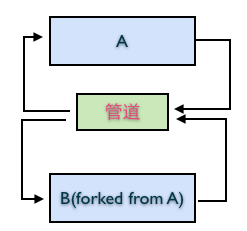所谓“进程间通信(IPC,inter-process communication)”,按照其目的讲就是让进程之间能够“共享数据”,“传输数据”,“事件通知”,“进程通知”等,我所知道的一共有“管道” “信号” “消息(报文)” “共享内存” “套接字” 这几种方式,我们会挨个挨个说,今天就说说管道。
所谓管道嘛,顾名思义类似于我们生活中的水管,只不过其中流动的是“数据”或者说一个一个字节,只能单向流动的我们称为“半双工”,能双向流动的称为“全双工”,其有两个端点,数据流入的那一端称为“写端”,反之则称为“读端”,这两个端点实际上是两个“描述字”。这样的管道可以连接在两个进程之间,成为数据传输的通道。
按照是否有名字,管道分为“未命名管道”也就是你经常看到的pipe,以及“有名管道”也就是你经常看到的FIFO(first in first out, 和数据结构中的FIFO一样,其也是按照“先进先出”的法则传输数据)。
1,pipe
pipe一词虽然是“管道”二字的英文翻译,但在这里其不是管道的统称,而是一种最基本和简单的管道形式:未命名管道。由于其没有名字(或者说id之类的),所以其无法在两个毫无干系的两个进程间使用。试想一下,进程A创建了一个管道,进程B无法去找到该管道并使用它,因为没有任何可拿去查找的凭据,连名字都没有... 但在一种特殊情况下其是有用的,如下图,假设进程A创建了一个管道:

其中的箭头代表数据写入和读出,很明显,进程A可以从管道的写端将数据写入,然后再从读端读出,但这似乎没有什么意义。
但,如果在管道建立以后,我们将进程A进行一次fork(),有意思的事情发生了, 子进程会复制父进程的大部分信息,这些信息里当然包含了代表了管道读端和写端的两个“描述字”(但管道仍然只有一份,就像被两个进程读写的某个硬盘文件只有一份一样),所以其就演变成下图这个样子:

如果此时,我们将上图中左上角以及右下角的两个箭头抛弃掉(相当于是说将这两个箭头所对应的描述字关闭), 那么就如下所示咯:

哈,注意到了吗?我们建立了一个从进程A流向进程B的数据通道。
那么,将上述过程写成代码的形式就很简单了。
首先是 int pipe(int f[2]) 这个函数,其需要头文件<unistd.h>,这个函数将创建一个未命名管道,并将管道的读端描述字包含在f[0]中,将写端描述字放在f[1]中,然后你就可以像利用普通文件描述字一样来读写数据了。
然后是fork函数,不多讲,不了解的同学一定要先搞清楚了,比如看这篇文章。
再次是int close(int fd) 函数, 其需要头文件<unistd.h>,其用于关闭指定的文件描述字。
最后是write和read函数, 其需要头文件<unistd.h>,用于读写数据。
OK,上代码:
#include <unistd.h>
#include <string.h>
#include <stdlib.h>
#define BUFF_SZ 256
int main()
{
printf("app start... ");
pid_t pid;
int pipe_fd[2];
char buf[BUFF_SZ];
const char data[] = "hi, this is the test data";
int bytes_read;
int bytes_write;
//clear buffer, all bytes as 0
memset(buf, 0, sizeof(buf));
//creat pipe
if(pipe(pipe_fd) < 0)
{
printf("[ERROR] can not create pipe ");
exit(1);
}
//fork an new process
if(0 == (pid=fork()))
{
//close the write-point of pipe in child process
close(pipe_fd[1]);
//read bytes from read-point of pipe in child process
if((bytes_read = read(pipe_fd[0], buf, BUFF_SZ)) > 0)
{
printf("%d bytes read from pipe : '%s' ", bytes_read, buf);
}
//close read-point of pipe in child process
close(pipe_fd[0]);
exit(0);
}
//close read-point of pipe in parent process
close(pipe_fd[0]);
//write bytes to write-point of pipe in parent process
if((bytes_write = write(pipe_fd[1], data, strlen(data))))
{
printf("%d bytes wrote to pipe : '%s' ", bytes_write, data);
}
//close write-point of pipe in parent process
close(pipe_fd[1]);
//wait child process exit
waitpid(pid, NULL, 0);
printf("app end ");
return 0;
}
运行输出为:
25 bytes wrote to pipe : 'hi, this is the test data'
25 bytes read from pipe : 'hi, this is the test data'
app end
2,FIFO
与“无名管道”不同的是,FIFO拥有一个名称来标志它,所谓的名称实际上就是一个路径,比如“/tmp/my_pipe”,其对应到磁盘上的一个管道文件,如果我们用file命令来查看其文件类型的话,会得到如下输出:
另外,我们需要知道的是,FIFO是单向(半双工)传输数据的。
函数 int mkfifo (char* path, mode_t mode) 负责创建FIFO管道,其需要头文件<sys/stat.h>,参数path即要创建的管道文件存放位置,mode参数即文件权限,更多的参考这里。
FIFO管道创建完成以后,便可以使用open函数来打开它,然后进行读写操作了。
看下面这个简单的demo,其将测试数据由进程A传递给进程B(为防止混淆视线,我将一些条件判断和异常处理代码删掉了):
先创建一个程序A,其负责创建FIFO管道,并向其中写入一些数据:
* process A: create FIFO and write data
*/
#include <stdio.h>
#include <stdlib.h>
#include <string.h>
#include <fcntl.h>
#include <limits.h>
#include <sys/types.h>
#include <sys/stat.h>
#include <unistd.h>
#define FIFO_NAME "/tmp/my_fifo"
int main()
{
int pipe_fd;
//if the pipe file do not exist
if (access(FIFO_NAME, F_OK) == -1)
{
//creat FIFO pipe file
mkfifo(FIFO_NAME, 0777);
}
//open FIFO pipe file.
//this will be brocked until some one open another end point(read-point) of this pipe
pipe_fd = open(FIFO_NAME, O_WRONLY);
//write data into pipe
write(pipe_fd, "hi, this is a test", PIPE_BUF);
//close FIFO pipe file descriptor
close(pipe_fd);
return 0;
}
然后创建程序B,它从管道中读取数据并显示出来:
* process B: read data from FIFO
*/
#include <stdio.h>
#include <stdlib.h>
#include <string.h>
#include <fcntl.h>
#include <limits.h>
#include <unistd.h>
#include <sys/types.h>
#include <sys/stat.h>
#define FIFO_NAME "/tmp/my_fifo"
#define BUFFER_SIZE PIPE_BUF
int main()
{
int pipe_fd;
char buffer[BUFFER_SIZE + 1];
//reset all bytes in buffer as '�'
memset(buffer, '�', sizeof(buffer));
//open FIFO pipe file.
//this will be brocked until some one open another end point(write-point) of this pipe
pipe_fd = open(FIFO_NAME, O_RDONLY);
if(read(pipe_fd, buffer, BUFFER_SIZE) > 0)
{
printf("data from FIFO : %s ", buffer);
}
//close pipe file descriptor
close(pipe_fd);
return 0;
}
运行下程序便会发现,无论是先运行A或是B,先运行起来的都会等待另外一个,这时open函数第二个参数的原因,我们可以添加O_NONBLOCK选项来取消阻塞。关于open函数,更多的看这里。
下面这个demo比较有意思,在程序A中敲入字符,其会立即传递给程序B(无需等待回车键),然后程序B会将它显示出来,关于如何取消控制台对回车键的等待,可以参考这里。
#include <stdlib.h>
#include <string.h>
#include <fcntl.h>
#include <limits.h>
#include <sys/types.h>
#include <sys/stat.h>
#include <unistd.h>
#include <termios.h>
#define FIFO_NAME "/tmp/my_fifo"
#define BUFFER_SIZE PIPE_BUF
static struct termios oldt;
//restore terminal settings
void restore_terminal_settings(void)
{
tcsetattr(0, TCSANOW, &oldt); /* Apply saved settings */
}
//make terminal read 1 char at a time
void disable_waiting_for_enter(void)
{
struct termios newt;
//Save terminal settings
tcgetattr(0, &oldt);
//init new settings
newt = oldt;
//change settings
newt.c_lflag &= ~(ICANON | ECHO);
//apply settings
tcsetattr(0, TCSANOW, &newt);
//make sure settings will be restored when program ends
atexit(restore_terminal_settings);
}
int main()
{
int pipe_fd;
int res;
char buffer[BUFFER_SIZE + 1];
memset(buffer, '�', sizeof(buffer));
//if the pipe file do not exist
if (access(FIFO_NAME, F_OK) == -1)
{
//creat FIFO pipe file
res = mkfifo(FIFO_NAME, 0777);
if (res != 0)
{
fprintf(stderr, "Could not create fifo %s ", FIFO_NAME);
exit(EXIT_FAILURE);
}
}
//open FIFO pipe file.
//this will be brocked until some one open another end point(read-point) of this pipe
pipe_fd = open(FIFO_NAME, O_WRONLY);
//if FIFO pipe file open sucessfully
if (pipe_fd != -1)
{
printf("input something and press RETURN ");
char ch;
disable_waiting_for_enter();
while ((ch = getchar()) != ' ')
{
buffer[0] = ch;
//write data into pipe
res = write(pipe_fd, buffer, BUFFER_SIZE);
if (res == -1)
{
fprintf(stderr, "Write error on pipe ");
exit(EXIT_FAILURE);
}
}
//close FIFO pipe file descriptor
close(pipe_fd);
}
else
{
exit(EXIT_FAILURE);
}
printf("Process %d finish ", getpid());
exit(EXIT_SUCCESS);
}
#include <stdlib.h>
#include <string.h>
#include <fcntl.h>
#include <limits.h>
#include <unistd.h>
#include <sys/types.h>
#include <sys/stat.h>
#define FIFO_NAME "/tmp/my_fifo"
#define BUFFER_SIZE PIPE_BUF
int main()
{
int pipe_fd;
int res;
char buffer[BUFFER_SIZE + 1];
//reset all bytes in buffer as '�'
memset(buffer, '�', sizeof(buffer));
//open FIFO pipe file.
//this will be brocked until some one open another end point(write-point) of this pipe
pipe_fd = open(FIFO_NAME, O_RDONLY);
if (pipe_fd != -1)
{
printf("data read from buffer : ");
//read all data from pipe file by BUFFER_SIZE each time
do
{
res = read(pipe_fd, buffer, BUFFER_SIZE);
if(res>0)
{
printf("%s", buffer);
fflush(stdout);
}
}while(res > 0);
//close pipe file descriptor
close(pipe_fd);
}
else
{
exit(EXIT_FAILURE);
}
printf(" Process %d finish ", getpid());
exit(EXIT_SUCCESS);
}
